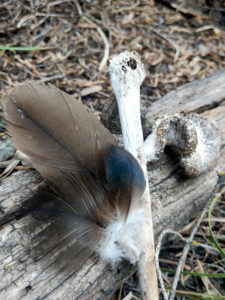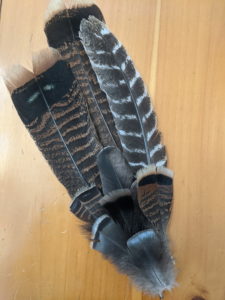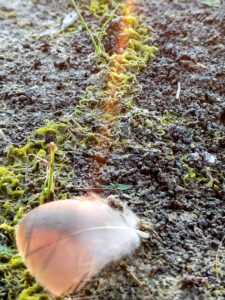 “Feathers fall; soft as a song, light as morning dreams.”
“Feathers fall; soft as a song, light as morning dreams.”
― Eirene Evripidou
I am hiking in Grove Creek Canyon along the Eastern foothills of Pleasant Grove, Utah, one of the several canyons close to my home. For a moment shadow blocks the mid-day sun from above. Looking up, I see the brilliant flame fan of the red tailed hawk, who gives out it’s familiar Screeeeee! It seems to be calling to me as it passes over head again and again, dropping bright feathers along the way to mark my path. I gather these enchanting “breadcrumbs” as I climb up the mountain side towards the jutting cliffs where my winged guide waits.
Such is one of the many dreams I have had over the past few years, that have featured one of my most favorite treasures to find when wandering: Feathers.
And it is conversely true to claim that following feathers has contributed greatly to my wandering.

A week ago, I was walking up the side of a particular mountain and came across several turkey vulture feathers. This is a place where I often find these remarkable raptor plumes and so I always have one eye to the ground. Turkey vulture feathers are a rich chocolate brown that fades from tawny to a beautiful snowy white. The micro barbs of some of the secondary flight feathers and the semi plumes act like a prism, refracting sunlight. In these feathers the result is a beautiful indigo iridescence. Many birds have feathers like this, such as hummingbirds, magpie, and wild turkey. It is utterly enchanting when viewed in person, and one of the many astounding and magical properties of feathers.
There is truly something fascinating about the structure of a feather in general. They look so delicate, yet they are built to endure extremes. Both Peregrines and Gyrfalcons can withstand up to 25 Gs. That’s over 2 times the amount of force (9 g) that a human can tolerate.

Feathers further provide insulation against the harshest of environments allowing birds to tolerate a wide range of temperatures from high heat to freezing.
Many birds also have specialized plumes which help a species to flourish in a variety of specific habitats, such as water fowl.
Through preening, aquatic birds are able to spread oils over their feathers to help repel the constant moisture of their watery existence. Water fowl feathers can often easily be identified by a a pronounced tegmen, or waxy layer which is found along the rachis of the primary and secondary feathers which further helps to keep these birds from becoming water logged.
Other birds have plumes that are built to absorb water such as the sandgrouse. Click on the link if you’d like to learn how these inventive birds use this specialized mechanism to reproduce and thrive in some of the most parched environments on earth.
Sure, a single feather is quite fragile, but the combined force and function of these structures on a single organism makes them a formidable evolutionary development.
Which Came First, the Bird or the Feather?
 Turns out it is the feather, as most Jurassic Park aficionados will gladly inform you. Flight was a later adaptation for this interesting feature, which it is theorized started out as an innovation for insulation or display. Sometimes I try to imagine beautifully plumed Utah-raptors – one of the largest variety of velociraptor running across the high desert mountain meadows where I wander. These feathered dromaeosaurids actually roamed a little further to the south of where I live, it seems. But still, it would be awesome to witness. Just not too close up!
Turns out it is the feather, as most Jurassic Park aficionados will gladly inform you. Flight was a later adaptation for this interesting feature, which it is theorized started out as an innovation for insulation or display. Sometimes I try to imagine beautifully plumed Utah-raptors – one of the largest variety of velociraptor running across the high desert mountain meadows where I wander. These feathered dromaeosaurids actually roamed a little further to the south of where I live, it seems. But still, it would be awesome to witness. Just not too close up!

If you wander long enough, you begin to notice the many patterns in nature and among these patterns is the seasonal nature of feather finding. Each bird has its migration and molting season. Likewise each has a breeding and hatching season. Also interactions with other creatures (most of the time, not so great an outcome for the smaller avian set) play a role in the finding of feathers.
In the fall, I have a favorite place to hunt for turkey feathers. These remain one of my favorite feathers to collect because of the sheer variety of patterns and colors to be found. They are just so pretty!
 But many times, you run across a feather, or a feather runs across you, without any apparent rhyme or reason. I have had this happen on many occasions and each time I feel a sense of wonder, honor and gratitude.
But many times, you run across a feather, or a feather runs across you, without any apparent rhyme or reason. I have had this happen on many occasions and each time I feel a sense of wonder, honor and gratitude.
Throughout time, feathers have been revered as having mystical/ magical properties. Many people believe that found feathers bear messages from higher beings, or from loved ones who have passed on. Sometimes a found feather is thought to infer magical properties, related to the type of bird it came from, to the person to whom the feather is gifted. Feathers have further played important roles in many cultural ceremonies that are deeply powerful and meaningful, from time immemorial.
 Feathers, are perhaps the perfect medium for such events, because of their ethereal nature and their inherent connection to wings and flight…something that lends the ability to move through space in four dimensions versus three as us poor naked apes seem to be bound to, without the aid of artificial devices. Furthermore, the inclination for up and sky to be associated with “heaven” and flight with angels, promotes this doubly.
Feathers, are perhaps the perfect medium for such events, because of their ethereal nature and their inherent connection to wings and flight…something that lends the ability to move through space in four dimensions versus three as us poor naked apes seem to be bound to, without the aid of artificial devices. Furthermore, the inclination for up and sky to be associated with “heaven” and flight with angels, promotes this doubly.
And who can really say these events are not serendipitous? The actual scientific reason behind such a kismet as finding a feather, can neither credit NOR can it discredit any meaning that might be in it. It is up to each individual to discover for themselves and I believe that is a beautiful gift.
There also many idioms or proverbs around feathers. One of the most well known is “birds of a feather flock together”. Which works as a conventional wisdom, as it’s often true that like minded people tend to gather.
 In actuality, however, birds often participate in what is called mixed species flocking. I think this fact is quite beautiful and actually points to a bigger wisdom, that was relayed to me once. And that is that we all bear and are sustained by the feathers from one single Great Bird.
In actuality, however, birds often participate in what is called mixed species flocking. I think this fact is quite beautiful and actually points to a bigger wisdom, that was relayed to me once. And that is that we all bear and are sustained by the feathers from one single Great Bird.
If there is one thing I have learned from nature, it’s that no organism, flora or fauna, can flourish and exists without all the other organisms. Everything is connected and interdependent in this miraculous web that is LIFE. We all partake, act and interact, what touches one, will eventually touch the other. It is beautiful, profound and terribly significant…
Feathers truly are magical in their variety. From the tiny fuchsia tipped jewel tones of the rock pigeon, to the bright cerulean of a jay, to the absolutely show stopping salmon and black feathers of the northern flicker. Each one is my favorite!!!
To me, finding feathers remains both a miracle and sign. A reminder of a past so vast and strange that we can only imagine, and a harbinger of hope towards a future in which possibility is as open and bright as a hawk circling the sun.
Have you found feathers that are significant to you? If so, please feel free to share in the comments below.
Disclaimer *Please be aware of any state or federal regulations regarding feather gathering, as there are several. But always it is perfectly okay to hunt for feathers to photograph.
Coming Soon! Learn more about the structure of a feather and the 7 types that are found on most birds, in our first video blog.
Until then, happy wandering…







Beautiful article! I shall look at found feathers with renewed interest.
My father often spoke of the great bird. Usually it was in jovial terms. He was a lover of birds, though, and had pigeons all his life. Why some of us are so drawn to birds has always been a curiosity to me. Your blog put some pieces in that puzzle.
Thank you for your comment Julie. Feel free to share what feathers you find and any significance there – in. 🙂